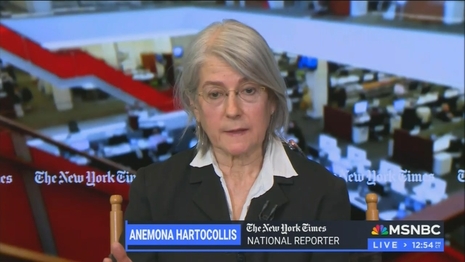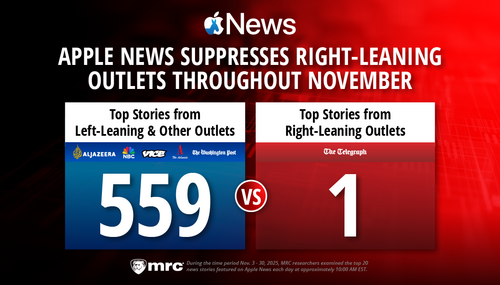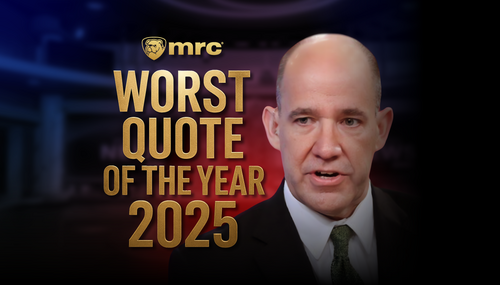 New York Times reporter Anemona Hartocollis blamed Republicans for the supposed suppression of free speech on campus lately – as in, why aren’t pro-Hamas campus activists able to disrupt classes, occupy buildings, and harass Jewish students -- in Tuesday’s “What Happened to Campus Activism Against the War in Gaza?”
New York Times reporter Anemona Hartocollis blamed Republicans for the supposed suppression of free speech on campus lately – as in, why aren’t pro-Hamas campus activists able to disrupt classes, occupy buildings, and harass Jewish students -- in Tuesday’s “What Happened to Campus Activism Against the War in Gaza?”
The war in Gaza was started by Hamas when they invaded Israel and killed or kidnapped over 1,000 Israeli civilians. But there was no attempt at balance. The only quoted material came in support of the pro-Hamas campus activists, with no dissenters from the one-sided tone.
Pro-Palestinian demonstrations swept through campuses across the country in the spring of 2024, leading to the arrests of more than 3,100 people. But in the more than a year and a half since, the protests have dissipated, even as the war in Gaza intensified.
Why the shift?
A major factor is the strict crackdown that universities waged on student protesters who built encampments on college campuses, beginning with Columbia and spreading across the country.
Universities that cracked down on students were facing sometimes extreme pressure from lawmakers in the Republican-controlled House Committee on Education and the Workforce. They argued the protests, including some of the slogans demonstrators used, were tinged with antisemitism, an accusation that protesters, some of whom were Jewish, strongly rejected.
Though many of the protests were peaceful, some turned destructive. Demonstrators broke into and occupied buildings on some campuses.
Protest groups said they were taking action because of the scale of death and destruction in Gaza, but some of the demonstrations frightened Jewish students. Other students complained that they disrupted classes.
Hartocollis shed tears over the occupiers and harassers facing consequences for their actions.
Historians say the United States had not seen so many people arrested in campus protests in 50 years, since the Vietnam War.
The campus disciplinary process can be protracted, lasting for a year or more and interrupting the course of students’ lives. Tori Porell, senior staff attorney at Palestine Legal, a group that has provided legal support to protesters, said she had clients who have had their diplomas withheld over protest activity.
“I have a number of clients at a number of schools who are in a really intolerable state of limbo, often can’t get jobs, have to delay grad school, have lost scholarships or fellowships,” Ms. Porell said, adding, “and psychologically it’s really troubling.”
Has the Times ever considered the "interruption" to normal students' lives caused by the menacing protests? Or the psychological toll of pro-Hamas chants and constant harassment of Jewish students on campus?
The story’s lowlight was the appearance of Nihad Awad of the Council for American-Islamic Relations (CAIR), an Islamic pressure group masquerading as a Muslim civil rights organization, who had previously declared himself happy about the October 7 massacre. Hartocollis didn’t mention that detail, which should surely lead to the dismissal of Awad as a reliable source.
But the impact of the protests should not be underestimated, said Nihad Awad, national executive director of the Council on American-Islamic Relations, a Muslim civil rights group. They had played a big role in awakening the public to the “atrocities” of the war in Gaza, he said.
If the protests have quieted, it has been because they have been effective, but also because they have been systematically suppressed, he said. The council has compiled a list of 28 universities that it says have “suppressed students advocating against apartheid, genocide and U.S.-backed military occupation.”
Those same students were chanting eliminationist rhetoric against Jews like “From the River to the Sea, Palestine Wil be Free!”
Gilead Ini of the Jewish media watchdog group Camera accused Hartocollis of having “whitewashed the nature of the movement she was describing. By concealing its open celebration of terrorism, she turned a story about campus free speech and fanaticism into a story about only the former — and in doing so guided readers to sympathize with those who endorse the worst massacre of Jews since the Holocaust.”




